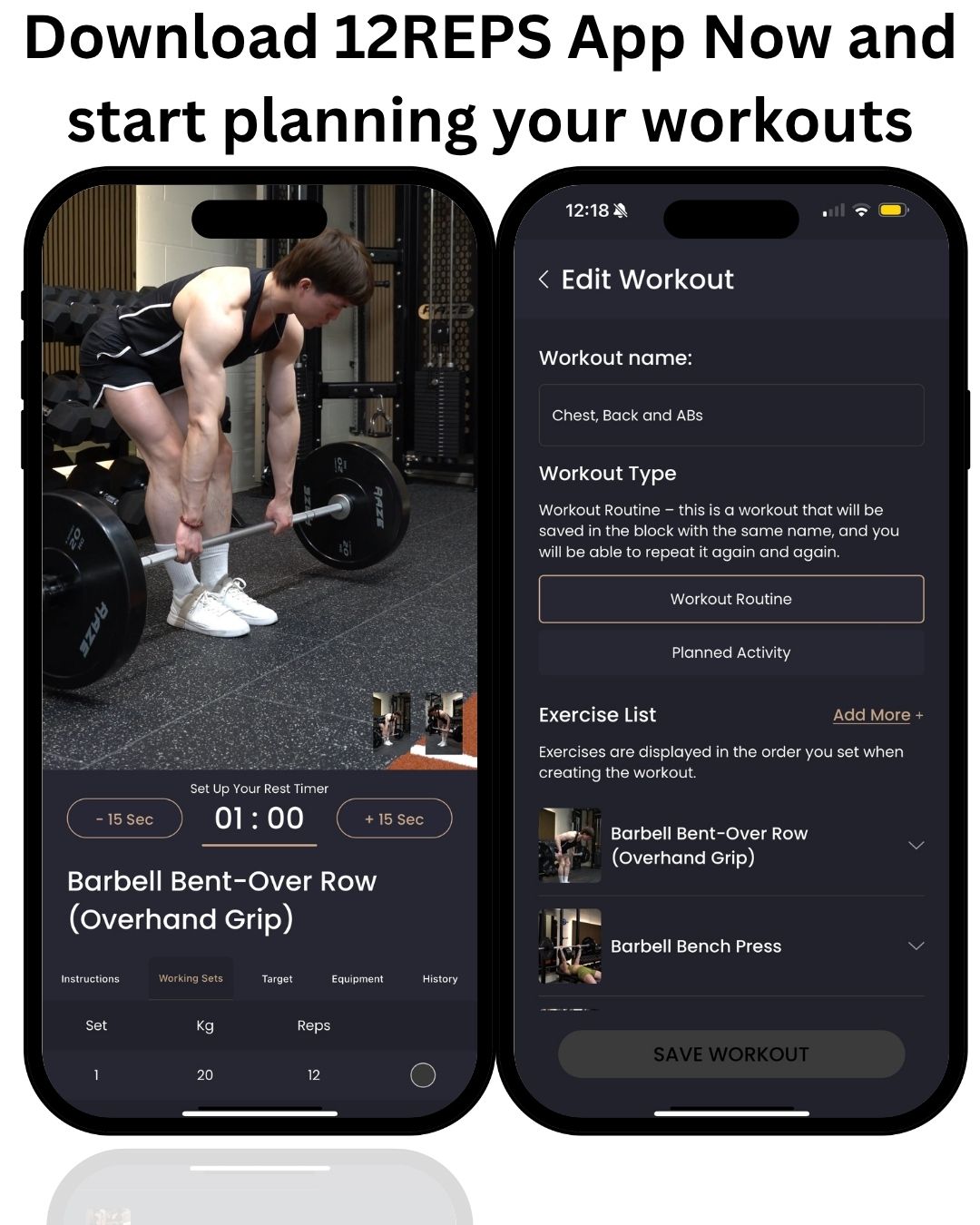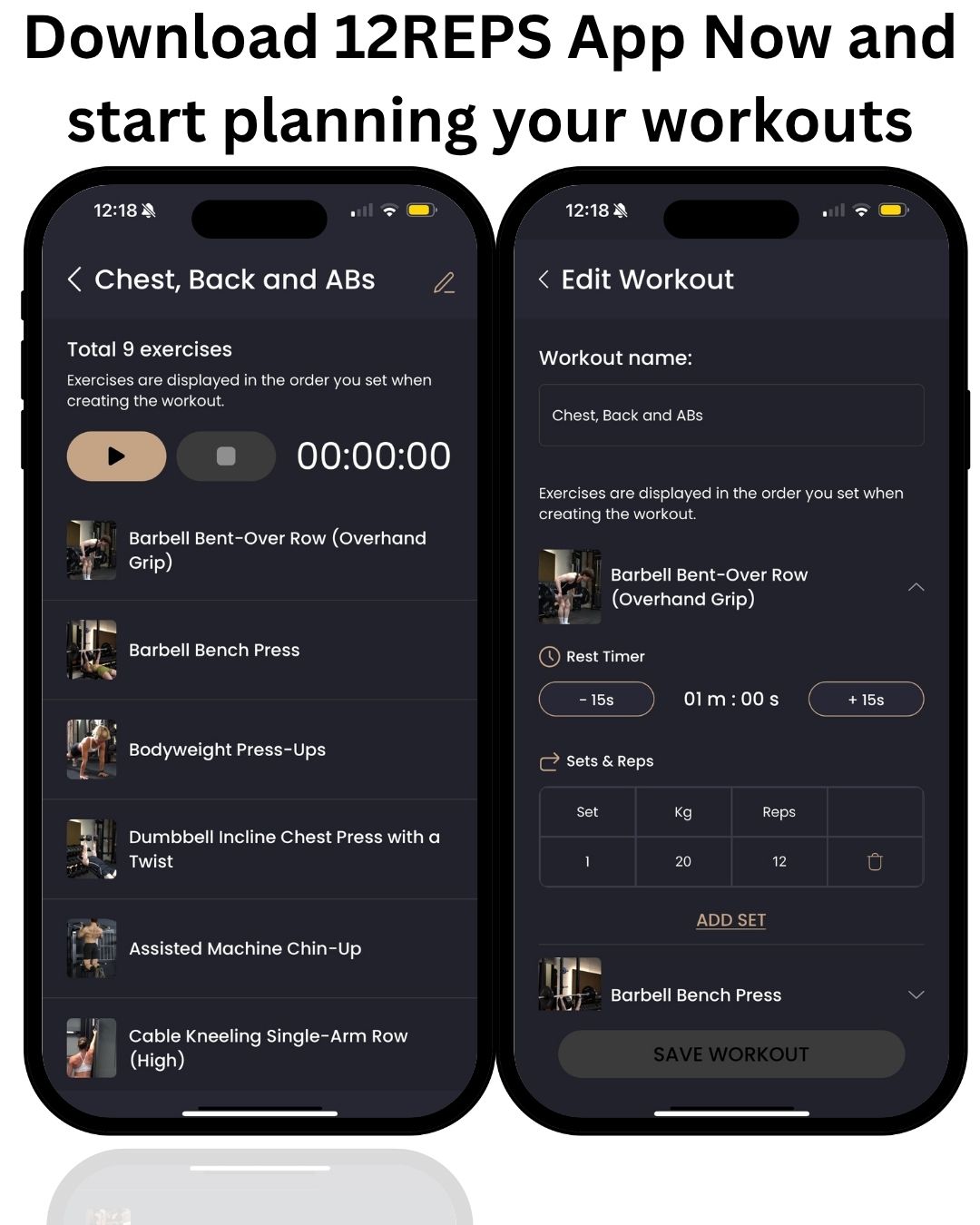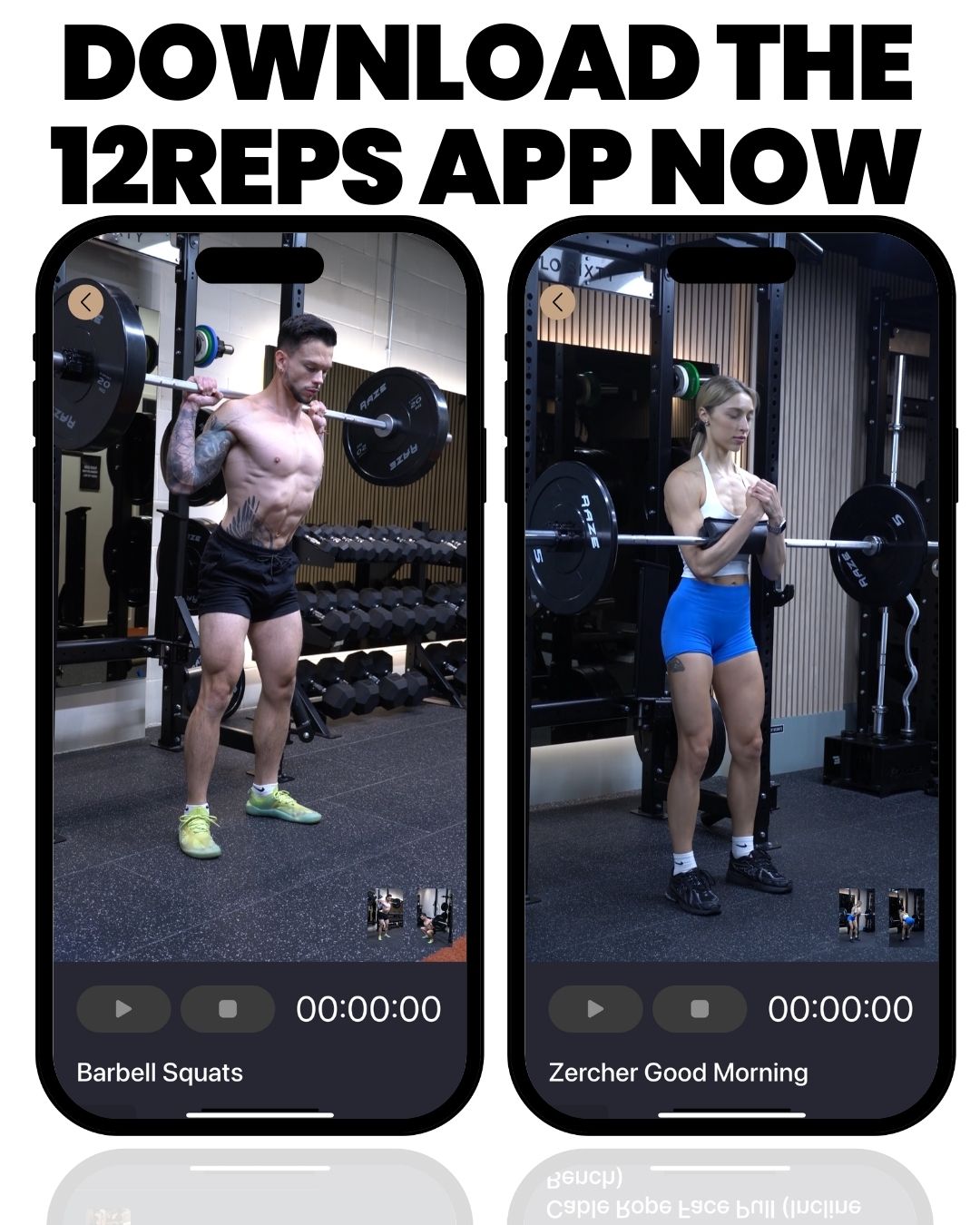By Will Duru, BSc (Hons) Sport and Exercise Science, Award-winning Personal Trainer with over 10 years of experience in strength training and optimising recovery
As someone who’s spent over a decade in the fitness industry, I’ve seen countless runners make the same mistake: focusing solely on logging miles while neglecting the foundation that supports every stride, strength training. If you’re preparing for a 10K and want to not just finish but excel, this comprehensive 12-week program combining strength training with strategic running will transform your performance.
This isn’t just another generic workout plan. It’s a scientifically-backed, progressive program designed specifically for runners who want to build strength, prevent injuries, and achieve their personal best. Using the innovative 12Reps app as your workout tracker, you’ll have access to exercise demonstrations, progress tracking, and the motivation of joining hundreds of users who are making their gym sessions more effective and enjoyable.

Why Strength Training is Essential for Runners
As a runner, your primary focus is on improving your endurance and speed. But what if I told you that the secret to unlocking your true running potential lies not just on the track, but in the weight room? For years, the myth that strength training makes runners bulky and slow has been debunked by science and proven by elite athletes. In fact, incorporating a structured strength training program into your routine is one of the most effective ways to enhance your performance, prevent injuries, and achieve a leaner, more powerful physique.
Injury Prevention: Your First Line of Defence
Running is a high-impact activity, and with every stride, your body absorbs a significant amount of force. Without a strong, resilient musculoskeletal system, this repetitive stress can lead to a host of common running injuries, such as runner’s knee, shin splints, and IT band syndrome. Strength training helps to fortify your muscles, tendons, and ligaments, making them better equipped to handle the demands of running. By strengthening the muscles around your joints, you create a more stable and supportive structure, reducing the risk of strain and injury. A study published in the British Journal of Sports Medicine found that strength training can reduce the risk of overuse injuries by almost 50% [1].
Running economy is a measure of how efficiently your body uses oxygen at a given pace. The more efficient you are, the less energy you expend, allowing you to run faster and longer. Strength training, particularly with heavy loads, has been shown to significantly improve running economy. A meta-analysis published in Sports Medicine concluded that strength training improves a range of factors that contribute to a better running economy, including maximal force production and rate of force development [2]. By increasing your muscular strength and power, you’ll be able to generate more force with each foot strike, propelling you forward with greater efficiency.
While running is an excellent way to burn calories, strength training is a powerful tool for building lean muscle mass. The more muscle you have, the higher your resting metabolic rate, which means you’ll burn more calories even when you’re not exercising. This can lead to a more favourable body composition, with a higher proportion of muscle to fat. For runners, this is a significant advantage, as a leaner physique can improve your power-to-weight ratio, making you a more efficient and faster runner.
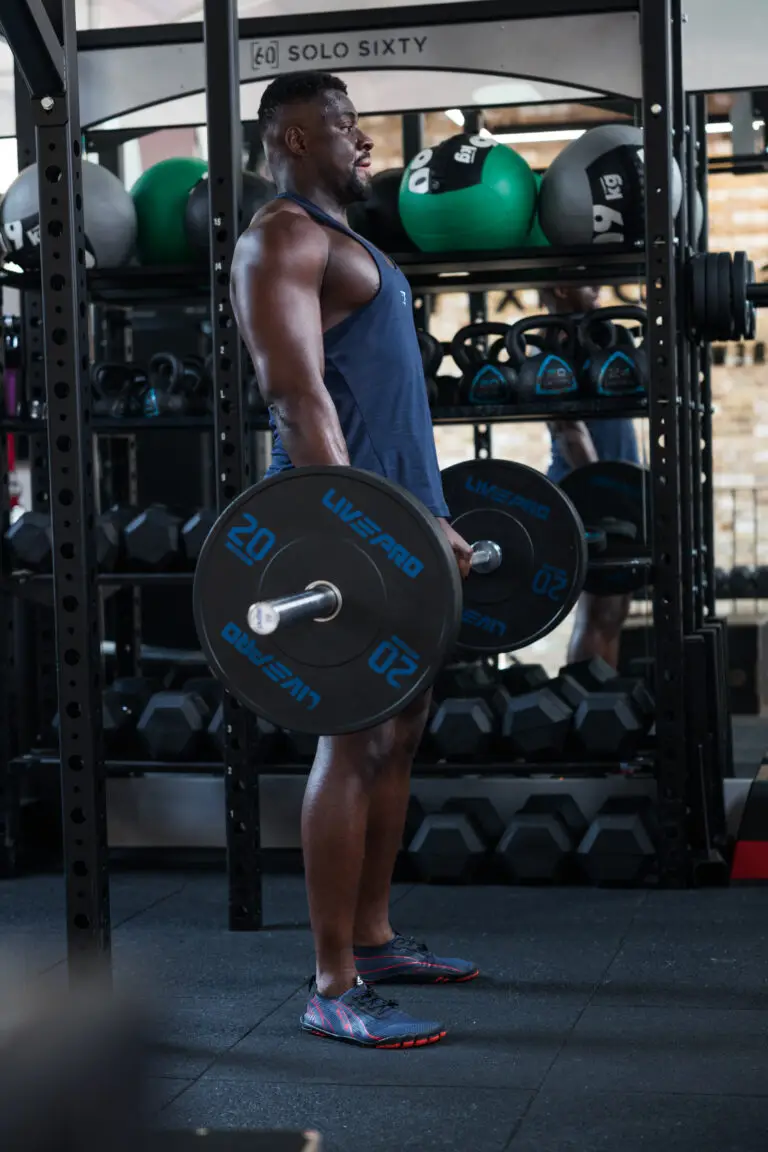
The 12Reps App: Your Ultimate Workout Tracker
The 12Reps App: Your Ultimate Workout Tracker
The 12Reps app is more than just a workout log; it’s a comprehensive tool designed to help you get the most out of your training. With hundreds of people already using it to simplify their gym lives, the app has become an indispensable companion for anyone serious about their fitness goals. Here’s how the 12Reps app can enhance your training:
- Exercise Demonstrations: Not sure how to perform an exercise correctly? The 12Reps app has you covered with a vast library of exercise demos. This feature is invaluable for ensuring you’re using the proper technique, which is crucial for maximising results and preventing injuries.
- Workout Tracking: The app makes it easy to track your workouts, including the exercises you perform, the number of sets and reps you complete, and the weight you lift. This data is essential for monitoring your progress and making informed decisions about when to increase the intensity of your workouts.
- Progress Tracking: The 12Reps app allows you to track your progress over time, so you can see how far you’ve come and stay motivated to keep pushing forward. You can track your 1RM (one-rep max), the total volume lifted, and other key metrics to get a complete picture of your strength gains.
- Community and Motivation: Join a community of like-minded individuals who are all working towards their fitness goals. The app’s social features allow you to connect with other users, share your progress, and get the support you need to stay on track.
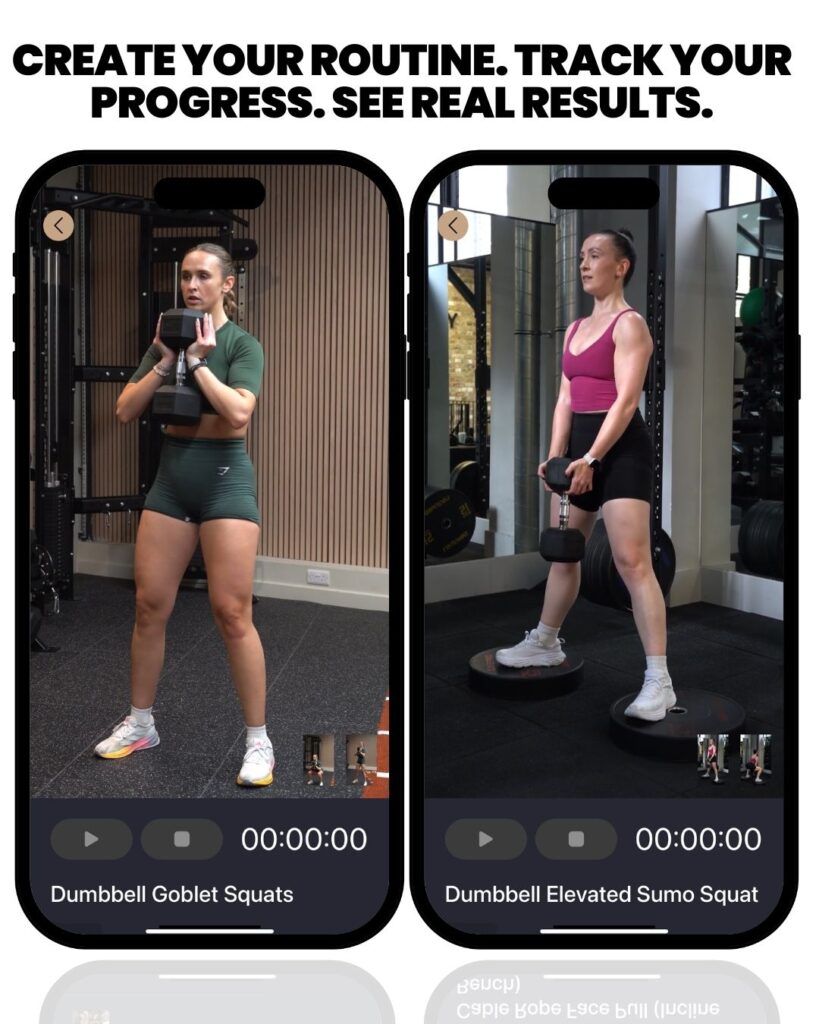
The 12-Week Program Structure
This 12-week program is divided into three phases, each lasting 4 weeks, with a specific focus. The program is designed to be progressive, with the intensity and volume increasing as you get stronger and fitter. The push/pull/legs split is a classic and effective way to organise your strength training, ensuring that you’re working all of your major muscle groups each week. The HIIT sessions will help you to improve your cardiovascular fitness and burn extra calories, while the running plan will prepare you for the specific demands of a 10K race.
Tracking Your Progress
To get the most out of this program, it’s essential to track your progress. The 12Reps app is the perfect tool for this, but you can also use a simple notebook or spreadsheet. Here’s what you should be tracking:
- Strength Training: For each exercise, record the date, the weight you lifted, the number of sets and reps you completed, and how you felt. This will help you track your strength gains over time and ensure you’re progressively overloading your muscles.
- Running: For each run, record the date, the distance you ran, your time, and how you felt. This will help you see your running fitness improve and ensure you’re on track to meet your 10K goal.
- Body Composition: While not essential, tracking your weight and body fat percentage can be a good way to see how your body is changing. You can do this once a week or once a month.
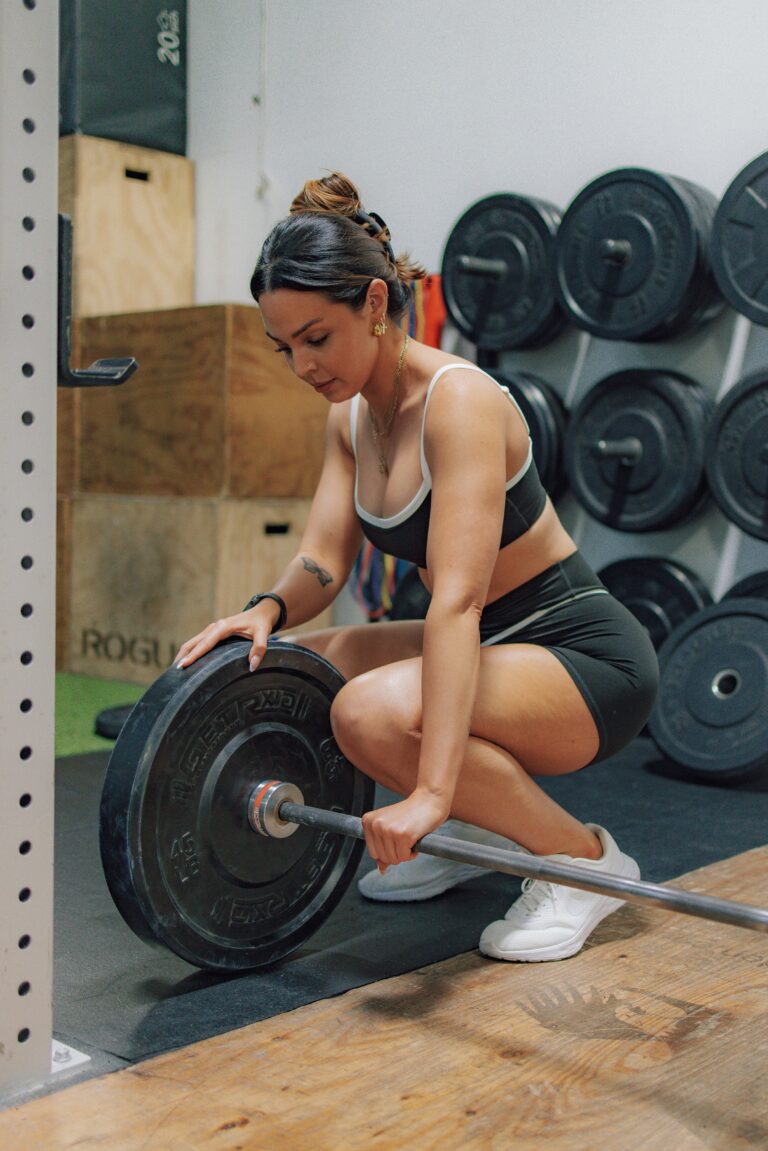
Phase 1: Foundation Building (Weeks 1-4)
Week 1-4 Strength Training Schedule
Monday – Push Day
Exercise | Sets | Reps | Weight | Rest Period | Equipment |
Dumbbell Chest Press | 4 | 10-12 | 15-20kg | 60-90 sec | Dumbbells |
Overhead Press | 4 | 10-12 | 12-15kg | 60-90 sec | Dumbbells |
Dumbbell Flyes | 4 | 10-12 | 8-12kg | 60-90 sec | Dumbbells |
Tricep Dips (Machine) | 4 | 10-12 | Bodyweight+10kg | 60-90 sec | Machine |
Push-ups | 4 | 10-12 | Bodyweight | 60-90 sec | Bodyweight |
Wednesday – Pull Day
Exercise | Sets | Reps | Weight | Rest Period | Equipment |
Lat Pulldown | 4 | 10-12 | 40-50kg | 60-90 sec | Machine |
Dumbbell Rows | 4 | 10-12 | 15-20kg | 60-90 sec | Dumbbells |
TRX Rows | 4 | 10-12 | Bodyweight | 60-90 sec | TRX |
Bicep Curls | 4 | 10-12 | 10-15kg | 60-90 sec | Dumbbells |
Face Pulls | 4 | 10-12 | 15-20kg | 60-90 sec | Machine |
Friday – Legs & Core
Exercise | Sets | Reps | Weight | Rest Period | Equipment |
Goblet Squats | 4 | 10-12 | 15-20kg | 90 sec | |
Romanian Deadlifts | 4 | 10-12 | 20-25kg | 90 sec | Dumbbells |
Walking Lunges | 4 | 10-12 each leg | 10-15kg | 90 sec | Dumbbells |
Plank | 4 | 30-45 sec | Bodyweight | 60 sec | Bodyweight |
Russian Twists | 4 | 10-12 each side | 8kg | 60 sec | Medicine Ball |
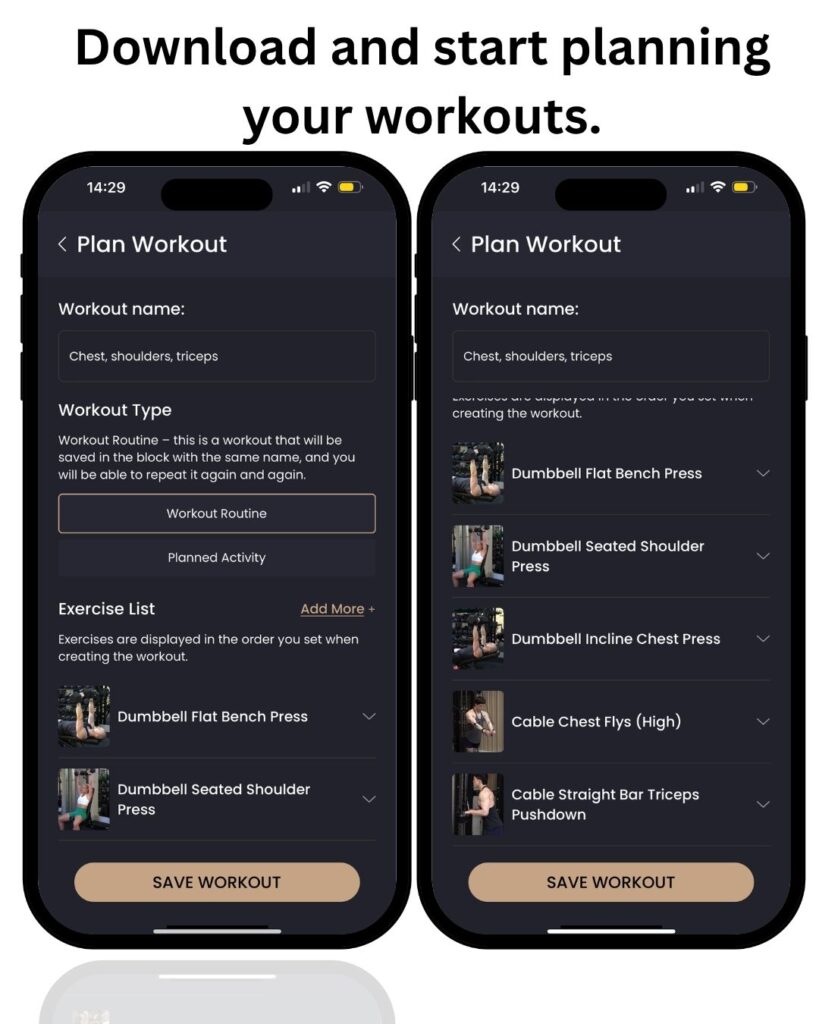
Phase 2: Strength Development (Weeks 5-8)
Week 5-8 Strength Training Schedule
Monday – Push Day
Exercise | Sets | Reps | Weight | Rest Period | Equipment |
Dumbbell Chest Press | 4 | 10-12 | 20-25kg | 60-90 sec | Dumbbells |
Overhead Press | 4 | 10-12 | 15-20kg | 60-90 sec | Dumbbells |
Incline Dumbbell Press | 4 | 10-12 | 15-20kg | 60-90 sec | Dumbbells |
Tricep Dips (Machine) | 4 | 10-12 | Bodyweight+15kg | 60-90 sec | Machine |
Medicine Ball Slams | 4 | 10-12 | 10kg | 60-90 sec | Medicine Ball |
Wednesday – Pull Day
Exercise | Sets | Reps | Weight | Rest Period | Equipment |
Lat Pulldown | 4 | 10-12 | 50-60kg | 60-90 sec | Machine |
Barbell Rows | 4 | 10-12 | 30-40kg | 60-90 sec | Barbell |
TRX Rows | 4 | 10-12 | Bodyweight | 60-90 sec | TRX |
Hammer Curls | 4 | 10-12 | 12-18kg | 60-90 sec | Dumbbells |
Cable Reverse Flyes | 4 | 10-12 | 20-25kg | 60-90 sec | Machine |
Friday – Legs & Core
Exercise | Sets | Reps | Weight | Rest Period | Equipment |
Barbell Squats | 4 | 10-12 | 40-50kg | 90 sec | Barbell |
Romanian Deadlifts | 4 | 10-12 | 30-35kg | 90 sec | Barbell |
Bulgarian Split Squats | 4 | 10-12 each leg | 15kg | 90 sec | Dumbbells |
Dead Bug | 4 | 10-12 each side | Bodyweight | 60 sec | Bodyweight |
Sandbag Slams | 4 | 10-12 | 15kg | 60 sec | Sandbag |
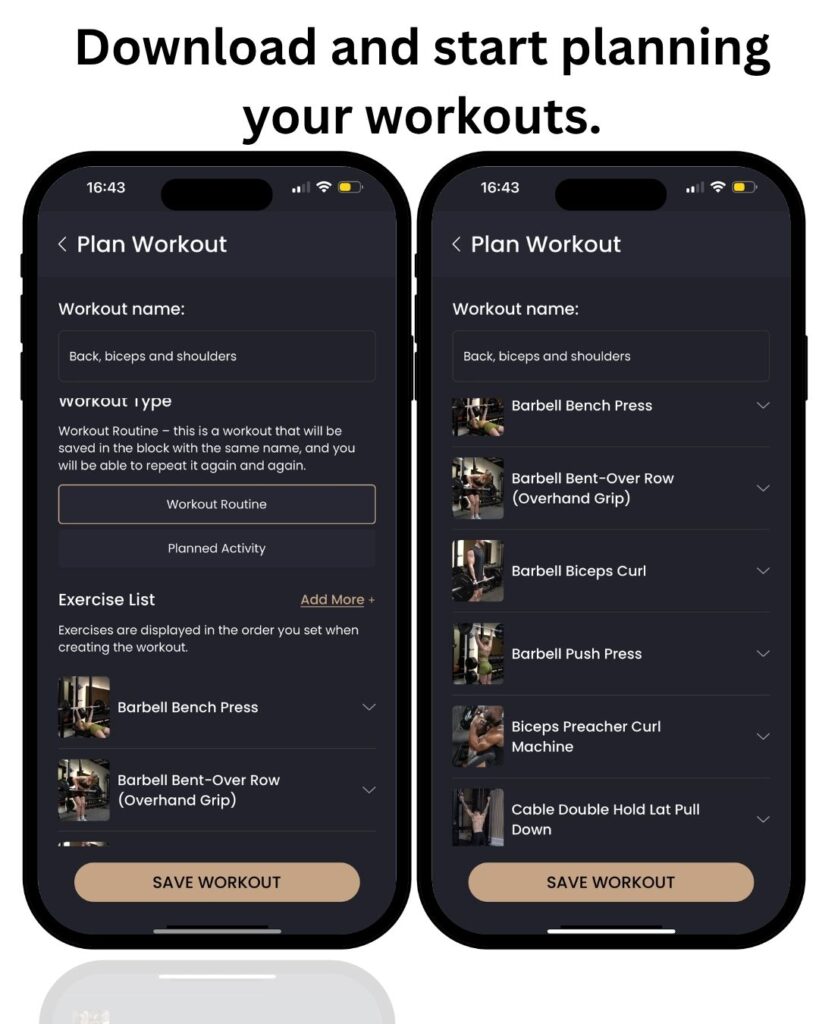
Phase 3: Peak Performance (Weeks 9-12)
Week 9-12 Strength Training Schedule
Monday – Push Day
Exercise | Sets | Reps | Weight | Rest Period | Equipment |
Dumbbell Chest Press | 4 | 10-12 | 25-30kg | 60-90 sec | Dumbbells |
Military Press | 4 | 10-12 | 20-25kg | 60-90 sec | Barbell |
Incline Dumbbell Press | 4 | 10-12 | 20-25kg | 60-90 sec | Dumbbells |
Close-Grip Push-ups | 4 | 10-12 | Bodyweight | 60-90 sec | Bodyweight |
Medicine Ball Slams | 4 | 10-12 | 12kg | 60-90 sec | Medicine Ball |
Wednesday – Pull Day
Exercise | Sets | Reps | Weight | Rest Period | Equipment |
Wide-Grip Pulldowns | 4 | 10-12 | 60-70kg | 60-90 sec | Machine |
Barbell Rows | 4 | 10-12 | 40-50kg | 60-90 sec | Barbell |
Single-Arm Dumbbell Rows | 4 | 10-12 each arm | 20-25kg | 60-90 sec | Dumbbells |
Barbell Curls | 4 | 10-12 | 20-25kg | 60-90 sec | Barbell |
TRX Face Pulls | 4 | 10-12 | Bodyweight | 60-90 sec | TRX |
Friday – Legs & Core
Exercise | Sets | Reps | Weight | Rest Period | Equipment |
Barbell Squats | 4 | 10-12 | 50-60kg | 90 sec | Barbell |
Sumo Deadlifts | 4 | 10-12 | 40-50kg | 90 sec | Barbell |
Reverse Lunges | 4 | 10-12 each leg | 20kg | 90 sec | Dumbbells |
Plank to Push-up | 4 | 10-12 | Bodyweight | 60 sec | Bodyweight |
Sandbag Carries | 4 | 20m | 20kg | 60 sec | Sandbag |
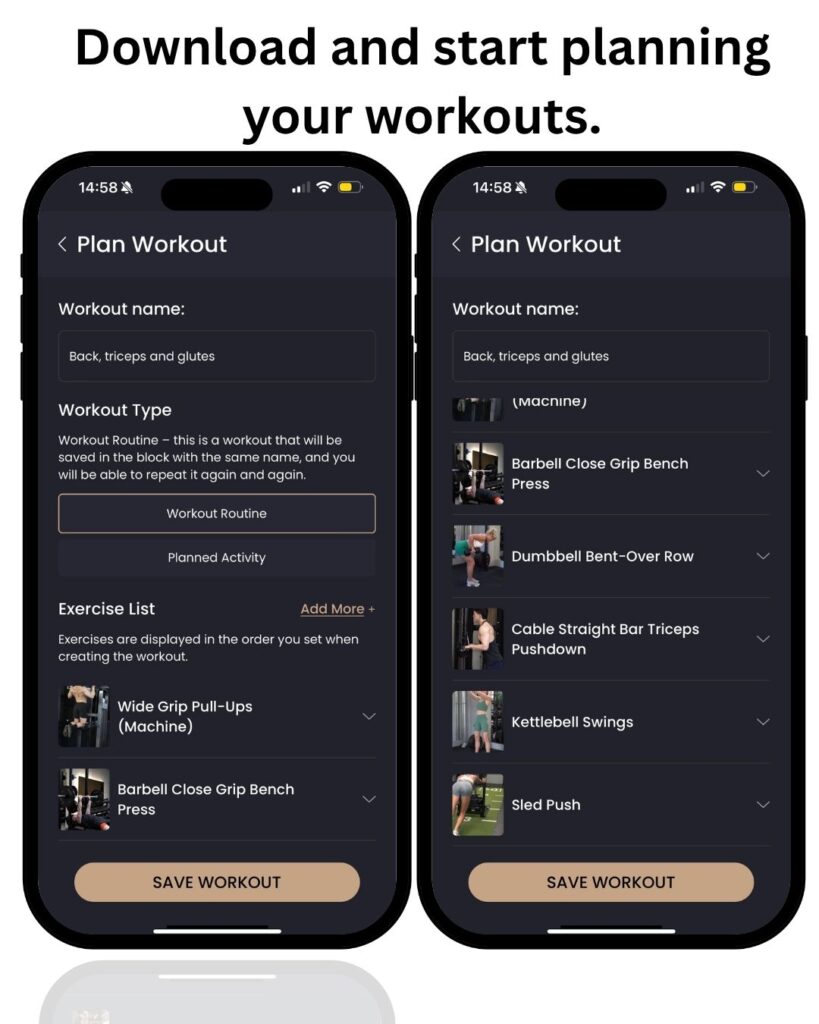
HIIT Cardio Sessions (Twice Weekly)
Tuesday & Saturday HIIT Sessions
Phase 1 HIIT (Weeks 1-4)
Exercise | Work Time | Rest Time | Rounds | Equipment |
Kettlebell Swings | 30 sec | 30 sec | 4 | Kettlebell (16kg) |
Sledge Push | 20 sec | 40 sec | 4 | Sledge |
Mountain Climbers | 30 sec | 30 sec | 4 | Bodyweight |
Medicine Ball Slams | 20 sec | 40 sec | 4 | Medicine Ball |
Burpees | 20 sec | 40 sec | 4 | Bodyweight |
Phase 2 HIIT (Weeks 5-8)
Exercise | Work Time | Rest Time | Rounds | Equipment |
Kettlebell Swings | 40 sec | 20 sec | 5 | Kettlebell (20kg) |
Sledge Push | 30 sec | 30 sec | 5 | Sledge |
High Knees | 40 sec | 20 sec | 5 | Bodyweight |
Sandbag Slams | 30 sec | 30 sec | 5 | Sandbag |
Jump Squats | 30 sec | 30 sec | 5 | Bodyweight |
Phase 3 HIIT (Weeks 9-12)
Exercise | Work Time | Rest Time | Rounds | Equipment |
Kettlebell Swings | 45 sec | 15 sec | 6 | Kettlebell (24kg) |
Sledge Push | 40 sec | 20 sec | 6 | Sledge |
Sprint in Place | 45 sec | 15 sec | 6 | Bodyweight |
Sandbag Slams | 40 sec | 20 sec | 6 | Sandbag |
Burpee Box Jumps | 40 sec | 20 sec | 6 | Box/Bodyweight |

10K Running Plan
Phase 1 Running Schedule (Weeks 1-4)
Thursday – Easy Run – Week 1: 20 minutes easy pace – Week 2: 22 minutes easy pace
– Week 3: 25 minutes easy pace – Week 4: 27 minutes easy pace
Sunday – Long Run – Week 1: 25 minutes steady pace – Week 2: 30 minutes steady pace – Week 3: 35 minutes steady pace – Week 4: 40 minutes steady pace
Phase 2 Running Schedule (Weeks 5-8)
Thursday – Tempo Run – Week 5: 5 min warm-up + 15 min tempo + 5 min cool-down – Week 6: 5 min warm-up + 18 min tempo + 5 min cool-down – Week 7: 5 min warm-up + 20 min tempo + 5 min cool-down – Week 8: 5 min warm-up + 22 min tempo + 5 min cool-down
Sunday – Long Run – Week 5: 45 minutes steady pace – Week 6: 50 minutes steady pace – Week 7: 55 minutes steady pace – Week 8: 60 minutes steady pace
Phase 3 Running Schedule (Weeks 9-12)
Thursday – Interval Training – Week 9: 5 min warm-up + 6×2 min intervals (1 min rest) + 5 min cool-down – Week 10: 5 min warm-up + 7×2 min intervals (1 min rest) + 5 min cool-down – Week 11: 5 min warm-up + 8×2 min intervals (1 min rest) + 5 min cool-down – Week 12: 5 min warm-up + 4×2 min intervals (1 min rest) + 5 min cool-down (taper)
Sunday – Long Run – Week 9: 65 minutes steady pace – Week 10: 70 minutes steady pace – Week 11: 45 minutes easy pace (taper) – Week 12: 30 minutes easy pace + 10K race

Conclusion
This 12-week strength training and running plan is a comprehensive and effective way to prepare for a 10 K race. By combining strength training, HIIT, and a structured running plan, you’ll not only be ready to tackle the race, but you’ll also be a stronger, faster, and more resilient runner. Remember to listen to your body, fuel yourself properly, and get enough rest. And with the 12Reps app as your guide, you’ll have everything you need to succeed.
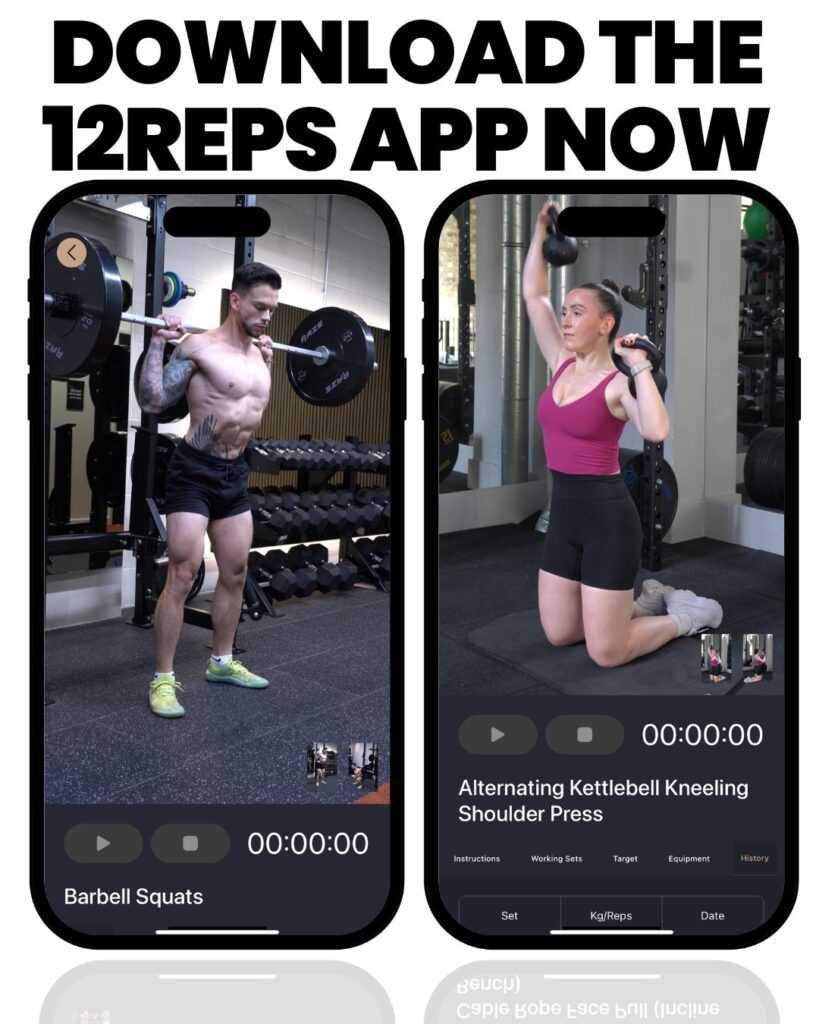
References
[1] Lauersen, J. B., Bertelsen, D. M., & Andersen, L. B. (2014). The effectiveness of exercise interventions to prevent sports injuries: a systematic review and meta-analysis of randomised controlled trials. British journal of sports medicine, 48(11), 871-877. https://bjsm.bmj.com/content/48/11/871
[2] Blagrove, R. C., Howatson, G., & Hayes, P. R. (2018). Effects of strength training on the physiological determinants of middle-and long-distance running performance: a systematic review. Sports Medicine, 48(5), 1117-1149. https://link.springer.com/article/10.1007/s40279-017-0835-7
[3] The 12Reps App. https://www.12reps.app


